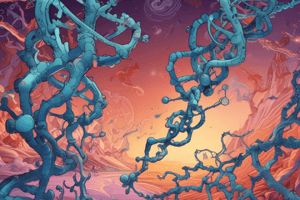Podcast
Questions and Answers
What is the process by which genetic information is converted into a functional product?
What is the process by which genetic information is converted into a functional product?
- Gene expression (correct)
- Gene segregation
- Gene mutation
- Gene replication
What is the sequence of events that describes how genetic information flows from DNA to proteins?
What is the sequence of events that describes how genetic information flows from DNA to proteins?
- Protein synthesis
- Cell division
- Central dogma (correct)
- Gene expression
What is the role of RNA polymerase in gene expression?
What is the role of RNA polymerase in gene expression?
- Replicating DNA
- Regulating gene expression
- Transcribing DNA into RNA (correct)
- Translating RNA into protein
What is the stage of gene expression where RNA is translated into protein?
What is the stage of gene expression where RNA is translated into protein?
What is the purpose of transcription factors in gene expression?
What is the purpose of transcription factors in gene expression?
What is the stage of gene expression where the RNA polymerase reaches the terminator region?
What is the stage of gene expression where the RNA polymerase reaches the terminator region?
What is the final product of gene expression?
What is the final product of gene expression?
What is the stage of gene expression where the small subunit of the ribosome binds to the mRNA?
What is the stage of gene expression where the small subunit of the ribosome binds to the mRNA?
Study Notes
Gene Expression
Overview
- Gene expression is the process by which the information encoded in a gene's DNA is converted into a functional product, such as a protein.
- It involves the transcription of DNA into RNA and the translation of RNA into protein.
Central Dogma
- The central dogma is the sequence of events that describes how genetic information flows from DNA to proteins:
- Replication: DNA is replicated to produce an identical copy of the genetic material.
- Transcription: DNA is transcribed into RNA, which is a complementary copy of the genetic code.
- Translation: RNA is translated into protein, which is the final product of gene expression.
Transcription
- Initiation: RNA polymerase binds to the promoter region of the gene, marking the start of transcription.
- Elongation: RNA polymerase reads the template DNA strand and adds nucleotides to the growing RNA chain.
- Termination: Transcription is halted when the RNA polymerase reaches the terminator region.
Translation
- Initiation: The small subunit of the ribosome binds to the messenger RNA (mRNA) and reads the start codon.
- Elongation: Amino acids are brought to the ribosome by transfer RNA (tRNA) and added to the growing protein chain.
- Termination: Translation is halted when the ribosome reaches a stop codon.
Regulation of Gene Expression
- Transcriptional regulation: Gene expression is regulated at the transcriptional level through the binding of transcription factors to specific DNA sequences.
- Post-transcriptional regulation: Gene expression is regulated at the post-transcriptional level through the degradation or stabilization of mRNA.
Key Players
- RNA polymerase: The enzyme responsible for transcribing DNA into RNA.
- Ribosome: The complex responsible for translating RNA into protein.
- Transcription factors: Proteins that bind to specific DNA sequences to regulate gene expression.
Gene Expression
- Gene expression is the process by which DNA information is converted into a functional product, such as a protein, through transcription and translation.
Central Dogma
- The central dogma outlines the flow of genetic information from DNA to proteins through replication, transcription, and translation.
Transcription
- Initiation: RNA polymerase binds to the promoter region, marking the start of transcription.
- Elongation: RNA polymerase reads the template DNA strand and adds nucleotides to the growing RNA chain.
- Termination: Transcription halts when the RNA polymerase reaches the terminator region.
Translation
- Initiation: The small subunit of the ribosome binds to messenger RNA (mRNA) and reads the start codon.
- Elongation: Amino acids are brought to the ribosome by transfer RNA (tRNA) and added to the growing protein chain.
- Termination: Translation halts when the ribosome reaches a stop codon.
Regulation of Gene Expression
- Transcriptional regulation: Gene expression is regulated through transcription factor binding to specific DNA sequences.
- Post-transcriptional regulation: Gene expression is regulated through mRNA degradation or stabilization.
Key Players
- RNA polymerase: The enzyme responsible for transcribing DNA into RNA.
- Ribosome: The complex responsible for translating RNA into protein.
- Transcription factors: Proteins that bind to specific DNA sequences to regulate gene expression.
Studying That Suits You
Use AI to generate personalized quizzes and flashcards to suit your learning preferences.
Description
Explore the process of gene expression, where genetic information in DNA is converted into a functional product, and learn about the central dogma that describes the flow of genetic information from DNA to proteins.




